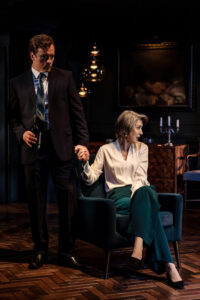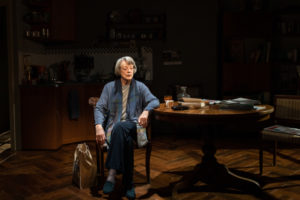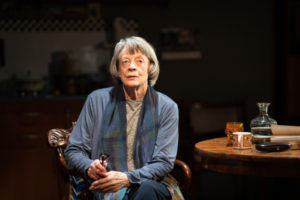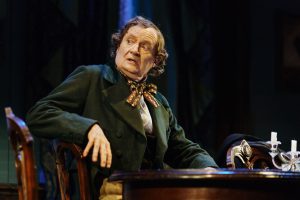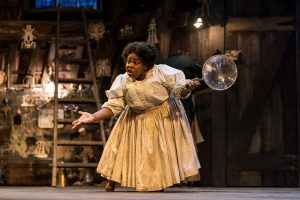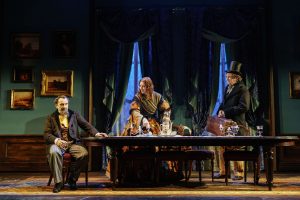Paul Bettany & Jeremy Pope light up this fascinating play
★★★★
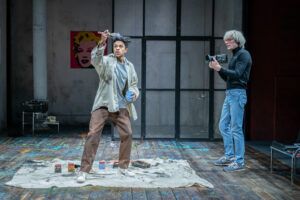
The Collaboration at The Young Vic is a special occasion. The two stars are Paul Bettany – Vision no less from the Marvel Universe, and the very unpleasant Duke of Argyll in A Very British Scandal – and Hollywood rising star Jeremy Pope.
The play is written by Anthony MacCarten, best known for his screenplays The Theory Of Everything, The Two Popes and Bohemian Rhapsody.
It’s about two of the great American artists of the late 20th century- Andy Warhol and Jean-Michel Basquiat– who worked together on a number of paintings. As you enter the Young Vic, you see scattered examples of their work scattered throughout the building.
When you walk into the auditorium, before the play even begins, there are flashing lights and the loud beat of a DJ – Xana – live mixing music and videos from 1980s New York project onto the set. There’s more. The director is Kwame Kwei-Armah, your actual artistic director of the Young Vic. And for good measure, the set is designed by Anna Fleischle, who triumphed just last week with The Forest at Hampstead Theatre, one of a long line of amazing productions, and now conjures up the two artists’ studios, both versions of the same white-painted brick walls, skylights and paint splattered floor, but each quite different in the details that represent the artists’ very different personalities. It is, as I said, an occasion.
In real life, when Warhol and Basquiat collaborated, the critics’ response was lukewarm, so was this collaboration of theatrical talent a similar damp squib? Quite the opposite. It’s an explosion of heat and light.
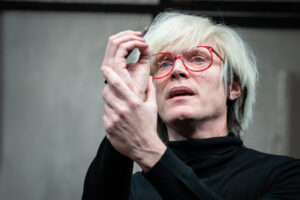
You can see why a play about this famous collaboration seemed like a good idea. You couldn’t get more different people. Warhol the established king of Pop Art, and Basquiat the young pretender whose neo-expressionist work went from street art to multi-million dollar sales at auction. Warhol old and in decline, Basquiat young and on the rise. Warhol the reserved germophobe who hid his heart, Basquiat, messy, prolific, spontaneous and wearing his heart on his sleeve.
They are The Odd Couple, as portrayed in the film of that name, or they could be a comedy duo like Morecambe and Wise, one that depends on a straight man and an anarchist. The conflict is the grit that creates this pearl of a story.
And what a great story. There are comparisons to be made with John Logan’s superb play Red which also features conversations about art, in that case between Mark Rothko and his young, critical assistant. Here, though, the two protagonists are shown as equals. Initially, they hate each other’s work. “So ugly’ says Warhol. ‘Old hat’ says Basquiat. So not exactly Elton John and Dua Lipa.
Paul Bettany and Jeremy Pope totally inhabit their roles
Then they meet and in the first act they explore one another’s ideas of art. Warhol sees himself as taking out the feeling by repetitive reproduction so that surface becomes all that matters, deliberately turning art into a commodity. ‘Trash. Trash. But we have to celebrate something’ says Warhol, (he might possibly have said that in the second act, I’m not sure). Basquiat passionately believes that art means something and can be an instrument for change. ‘Art disturbs the comfortable and comforts the disturbed’ he says. In this play of natural conversation, even the aphorisms sound spontaneous. There are times in the first act when you may wonder, interesting and enjoyable as the conversation is, whether it’s getting anywhere.
The second act dispels all doubt. It takes place when they have been working together for a couple of years, and starts with a splendid moment when Warhol unhappy with the standard of cleaning in Basquiat’s studio starts vacuuming. The two have got to know one another well and, while they remain very different artists, they have come to feel a kind of love for each other. And it’s heartwarming in this current era of echo chambers and cancel culture, to see two people with very different views, not shutting each other out, but listening, and talking, and eventually respecting one another.
The intimacy the artists now have means that we find out a lot more about their inner selves: Warhol opens up emotionally in ways you would never have imagined, and we learn about Basquiat’s demons too. In some ways, the collaboration has reinvigorated Warhol. There’s a wonderful moment in the first act when he first picks up a brush for the first time in 25 years and seems to marvel at its feel in his hand. He has become a kind of father figure to Basquiat who seems to be on a downward spiral of paranoia and drug addiction.
This all works so well, partly because of the strength of the dialogue, partly because of the way director Kwame Kwei-Armah drives the play towards a dramatic climax. Most of all it’s because of the acting. Paul Bettany and Jeremy Pope totally inhabit the roles of Andy Warhol and Jean-Michel Basquiat. Mr Bettany looks the part with his gangly body, his nervous tics and his pale skin and white wig. When he talks with Warhol’s superficial ‘gosh, gee’ way of speaking, his controlled body language conveys that this is a way of hiding his true self, just as he hides behind a camera.
Mr Pope with hair like a crown of thorns is all bouncy and Tigger-like then suddenly switches to anger, both moods concealing a pain that can be seen in the way he physically slumps or has a watery look in his eyes.
These two outstanding performances turn this theatrical collaboration into a momentous occasion.
The Collaboration can be seen at the Young Vic until 2 April 2022.
Click here to watch this review on the One Minute Theatre Reviews YouTube channel
